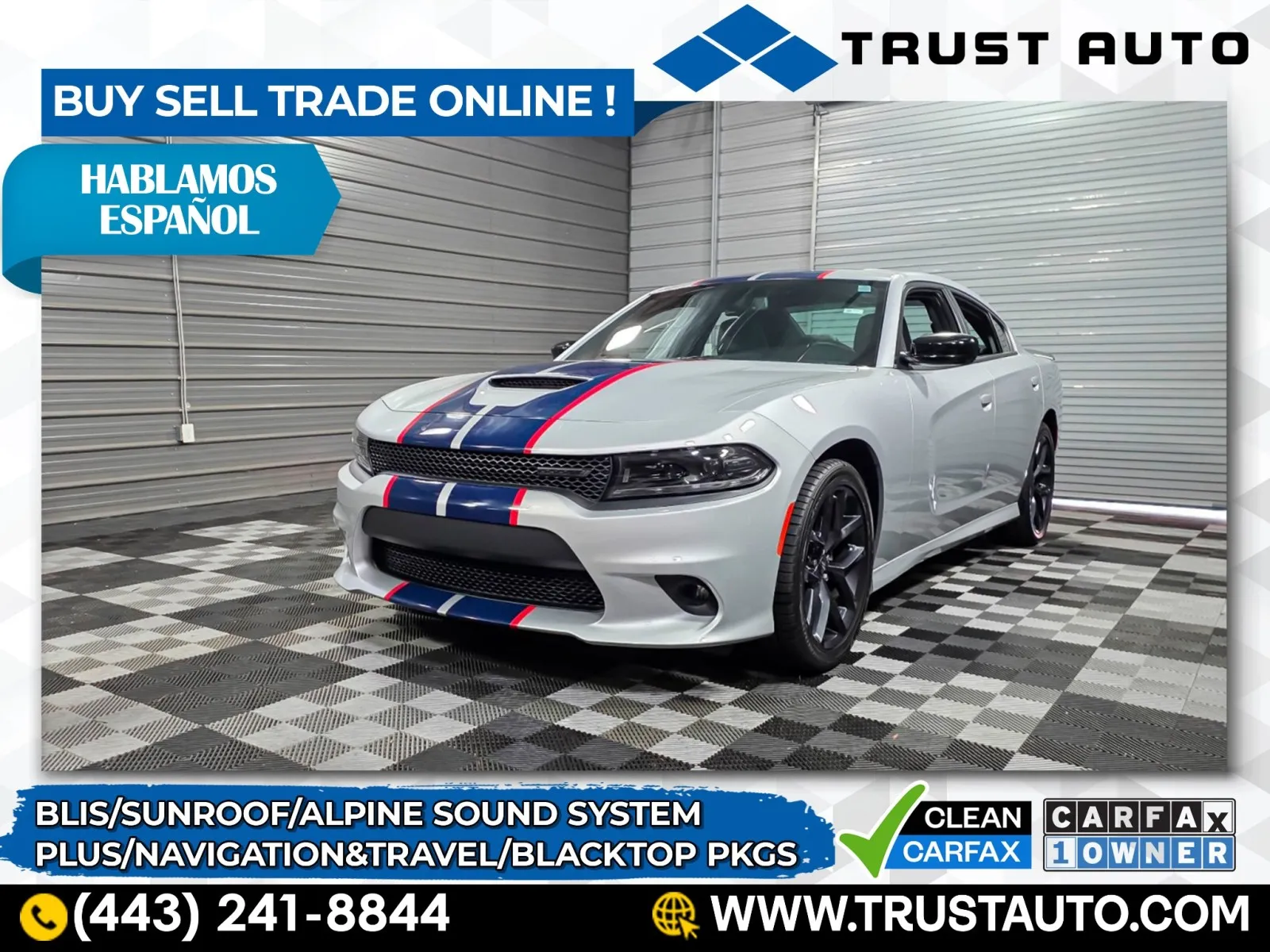Used Muscle Cars for Sale in Maryland
Table of Contents
- Muscle Cars for Sale Near You: Challenger, Camaro, or Mustang
- Rise of the Pony Car
- Say Goodbye to American Muscle (For a While)
- Decades of Improvement
- 21st Century American Muscle Cars
- Best American Muscle Cars
- Dodge Challenger for Sale | Muscle Cars For Sale
- Chevrolet Camaro for Sale | Muscle Cars For Sale
- Ford Mustang For Sale | Muscle Cars For Sale
- Muscle Cars for Sale Near Me

Muscle Cars for Sale Near You: Challenger, Camaro, or Mustang
American muscle cars can trace their origins to 1949 when Oldsmobile dropped a 135-horsepower V-8 into a Rocket 88. But things improved as the next decade rolled around. In 1955, Chrysler stuffed a 300-horsepower Hemi V-8 into its C-300 to produce Detroit’s most powerful car for that year. While tame by today’s standards, this capable cruiser topped out at 130 mph and could hit 60 mph from a standstill in 9.8 seconds. But Detroit and the car-buying public were never happy with the status quo. This helped usher in the 1960s and the golden age of American muscle.
As Ford, Dodge, and other automakers dabbled with off-the-shelf parts and big-block V-8s (engines with more than 400 cubic inches), the automotive world’s jaw dropped with the debut of the 1964 Pontiac GTO . Its 389 cubic-inch engine enabled a 0-60 time of 7.7 seconds and a 15.8-second quarter-mile time. It drove fast and had looks to match.
Rise of the Pony Car
But the industry never stood still for very long as the Ford Mustang hit the scene. Americans couldn’t get enough of the Blue Oval’s pony car. What’s a pony car? It’s a term coined to describe an affordable sporty coupe or convertible. It was first used to describe the Plymouth Barracuda (that beat the Mustang to market by a couple of weeks) and later got attached to the Mustang.
General Motors followed with its own pony cars: the Chevrolet Camaro and Pontiac Firebird. As did American Motors with the AMX. And Chrysler squeezed out another offering with the debut of the Dodge Challenger in 1969. Detroit continued to shove all sorts of big blocks and Hemis into just about anything that could fit these engines. Enthusiasts turned up their noses at cars with anything under 400 cubic inches under the hood.
“Pony car” and “muscle car” are often used interchangeably, but a muscle car generally refers to a high-power vehicle. While a pony car may give off sporty vibes with or without the horsepower to back up its looks.
Say Goodbye to American Muscle (For a While)
The muscle car era entered the 1970s with the best of intentions. But outside factors pulled the rug from out under automakers and enthusiasts. Onerous federal emission standards became the law of the land, and oil embargoes made single-digit fuel economy a thing of the past. Insurance companies were also tacking on hefty premiums for high-performance vehicles.
Muscle cars started to drop like flies. The Plymouth‘Cuda was relegated to the history books, and the Dodge Challenger would have to wait for reincarnation. Once storied muscle-car names like the Dodge Charger and Chevrolet got reinvented as personal luxury coupes.
The Mustang, Camaro, and Firebird hung on as shadows of their former selves. Engine output was anemic at best as automakers concentrated on fuel economy and keeping the government happy. It took almost a decade for engineering to catch up with the real world. The venerable 5.0 V-8 appeared in the 1982 Mustang, and the 1987 Buick GNX demonstrated what turbocharging could do to a V-6 engine.
Decades of Improvement
The rest of the 20th century saw steady advancements, with most attention focused on the Mustang, Camaro, and Firebird. Chrysler and AMC were out of the muscle car game at this point.
This time also saw the rise of high-performance cars from Japan, such as the Nissan 300ZX, Toyota Supra, and Mitsubishi 3000GT. While none of these imports carried the muscle car moniker, their high-output four- and six-cylinder engines definitely stole sales from Ford and GM.
21st Century American Muscle Cars
The new century marked significant changes in the muscle car world. Faced with declining sales, General Motors axed the Camaro and Firebird after 2002. This left the market solely to the Ford Mustang.
Sensing an opportunity, Chrysler re-entered the competition in 2008 by reviving legendary nameplates: the Dodge Challenger and Dodge Charger . Cleverly, the Charger became a four-door sedan, offering muscle-car abilities in a family-friendly package. Feeling left out, Chevrolet relaunched an all-new Camaro for 2010. Shoppers looking for the best American muscle cars could now choose from three automakers.
Now that we’ve covered the American muscle car story in under three minutes let’s look at recent examples of muscle cars for sale. Here’s a dive into the more recent offerings from Detroit.
Best American Muscle Cars
Dodge Challenger for Sale | Muscle Cars For Sale
Using the original Challenger for inspiration, Dodge put a modern spin on the third-generation version (the second-gen Challenger was a forgettable rebadged Mitsubishi coupe from four decades ago). This was when new versions of nostalgic vehicles were hot in the general marketplace. A trend exemplified by the resurrected Volkswagen Beetle , for example.
And while base models like the SE and SXT came with a 250-horsepower 3.5-liter V-6, a 5.7-liter Hemi V-8 pushed out up to 375 horsepower and 404 lb-ft of torque. Respectable performance for a decade and a half ago.
Horsepower and performance inched up throughout the years. By 2011, the base power plant was a new 3.6-liter V-6 with 305 horsepower. The SRT-8 also received a new engine. This 6.4-liter Hemi V-8 pushed out 470 horsepower and 470 lb-ft of torque and hit a 170 mph top speed. 0-60 mph required only 4.5 seconds.
2015 was another significant year as the car benefited from a facelift and the introduction of the Challenger SRT Hellcat variant. Equipped with a supercharged 6.2-liter Hemi with 707 horsepower and 650 lb-ft of torque, this car maxed out 199 mph and could do a zero to 6- mph run in 3.6 seconds.
The 2021 Dodge Challenger SRT Hellcat has even better specs with 717 horsepower and 656 lb-ft of torque. Other options include the 2021 Dodge Challenger R/T with a 5.7-liter V-8 making 375 horsepower and 410 lb-ft of torque. With 485 horsepower and 475 lb-ft of torque, the Dodge Challenger Scat Pack slots in nicely between the Hellcat and R/T. Unique among the Challenger lineup (and other American coupes) is the Dodge Challenger GT with an all-wheel-drive setup. The drivetrain gets paired with the 305-horsepower Pentastar V-6.
Chevrolet Camaro for Sale | Muscle Cars For Sale
While the Camaro has an almost 60-year legacy , this American muscle car became relevant after its 2010 reintroduction (as the fifth generation). A 312-horsepower V-6 pushed the LS and LT trims, while the SS came with two different V-8s: A 400-horsepower L99 paired with a six-speed automatic, and a 426-horsepower LS3 came with the six-speed manual transmission.
As the fifth-generation Camaro wound down, Chevy offered a Z/28 version with a 505-horsepower 7.0-liter LS7 V-8. A 4.5-second time for a 0-60 run helped the Camaro hold its own. But the supercharged ZL1 (using a 580-horsepower 6.2-liter V-8) did the Z/28 one better with a sub-four second run time.
An all-new Camaro appears for 2016 as Chevy worked to keep up with the Challenger and Mustang. Power plants now begin with a turbo 2.0-liter four-cylinder engine with 275 horsepower. In the middle of the pack is a new 3.6-liter V-6 making 335 ponies. A 6.2-liter LT1 now making 455 rests in the Camaro SS. Besting the SS is the ZL1 with a supercharged LT4 engine making 650 horsepower; it can hit 205 mph.
If you like your muscle cars with a bowtie, be sure to check out any Chevrolet Camaro SS for sale. General Motors is discontinuing the entire Camaro lineup after 2024.
Ford Mustang For Sale | Muscle Cars For Sale
There are few names as legendary in automotive history as the Ford Mustang . One of the original pony cars, the Mustang, has transformed over time into a muscle car that borders onto supercar territory (like its Hellcat and ZL1 competitors).
The current (sixth) generation has been around since 2015. Its fastback styling harkens to the original Mustang, but a chiseled front end and sweeping hood line give this car an aggressive look. In the early years of the S550 (Ford’s internal code for this Mustang), buyers could choose from a turbo four-cylinder, a V-6, and different V-8 options. But Ford dropped the V-6 after 2017 because the EcoBoost four-cylinder offered more horsepower (up to 330 ponies) and better gas mileage.
For base V-8 power, the 5.0-liter Coyote V-8 sits under the GT’s hood. Its 460 horsepower and 420 lb-ft of torque (450 hp/410 lb-ft for 2022 models) offer thrilling performance without the need for a supercharger or outrageous insurance premiums. Of course, there are other Mustangs if the GT isn’t enough.
The GT350 (2015-2020) offers a V-8 engine with 526 horsepower and 429 lb-ft of torque. But, when all else fails, the Shelby GT500 is the top-dog Mustang. Its supercharged 5.2-liter Voodoo V-8 cranks out 760 horsepower and 625 lb-ft of torque. So that means 0-60 mph comes as fast as 3.4 seconds. There are not too many cars on the road that can achieve this.
Muscle Cars for Sale Near Me
Trust Auto in Sykesville is Maryland’s muscle car headquarters. Our wide selection includes used Dodge Challengers , Chevy Camaros, and Ford Mustangs. Importantly, every car is hand selected for quality and value. Stop by our showroom for a test drive, or take advantage of our all-online shopping experience (including virtual test drives!).




